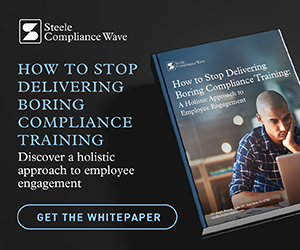In a recent entry on his always excellent blog, SCCE CEO Roy Snell talks about a  study in which the use of the word “because” is shown to be powerfully effective in influencing others. (“We need to leave now” is presumably less effective than “We need to leave now because we are about to be late.”) Roy makes a point about the quality and integrity of the “because.” “We need to formulate our “because”… thoughtfully before we ask people to do things,” he says. “People can see through and are not motivated by the ‘manufactured because.’”
study in which the use of the word “because” is shown to be powerfully effective in influencing others. (“We need to leave now” is presumably less effective than “We need to leave now because we are about to be late.”) Roy makes a point about the quality and integrity of the “because.” “We need to formulate our “because”… thoughtfully before we ask people to do things,” he says. “People can see through and are not motivated by the ‘manufactured because.’”
In the comments below his article, a commenter muses about whether using the word “because” would help a person skip to the front of the line at Starbucks. Imagine: “I’d like to cut in front of you in line, because I need to get a cup of coffee.” You wouldn’t think that would work.
However, if you look at the study, it appears that the opposite is true. In his watershed book Influence: The Psychology of Persuasion, Social Psychologist Robert Cialdini unpacks the details. It is a study by Harvard psychologist Ellen Langer which demonstrated just how powerful this simple device can be.
A well-known principle of human behavior says that when we ask someone to do us a favor we will be more successful if we provide a reason. People simply like to have reasons for what they do. Langer demonstrated this unsurprising fact by asking a small favor of people waiting in line to use a library copying machine: Excuse me, I have five pages. May I use the Xerox machine because I’m in a rush? The effectiveness of this request-plus-reason was nearly total: Ninety-four percent of those asked let her skip ahead of them in line.
Compare this success rate to the results when she made the request only: Excuse me, I have five pages. May I use the Xerox machine? Under those circumstances, only 60 percent of those asked complied. At first glance, it appears that the crucial difference between the two requests was the additional information provided by the words, “because I’m in a rush.
But a third type of request tried by Langer showed that this was not the case. It seems that it was not the whole series of words, but the first one, “because,” that made the difference. Instead of including a real reason for compliance, Langer’s third type of request used the word “because” and then, adding nothing new, merely restated the obvious: Excuse me, I have five pages. May I use the Xerox machine because I have to make some copies? The result was that once again nearly all (93 percent) agreed, even though no real reason, no new information, was added to justify their compliance.
Why is this important? Because it suggests that there are some very simple linguistic tools that can be used to powerfully influence the behaviors of others and that those who wield such tools will have a great deal of influence over those who don’t. In fact, there are whole groups of professionals that understand such tools and use them daily – sometimes in highly manipulative ways. Advertisers and politicians are two that come to mind.
Another group that needs to be equally facile with such behavior influencing techniques is compliance professionals; compliance is one of those professions where being able to influence the behaviors of others is fundamental to doing our jobs. Understanding how to use such methodologies in communication is crucial to the success of our compliance message. While the “because” method seems almost absurdly simplistic, there are a number of such tools that, used effectively, can transform the power of compliance communications. I will explore some of these in future posts.
COMPLIANCE COMMUNICATIONS TIP: Get familiar with the simple devices and techniques that have been proven to influence human behaviors as you create your compliance communications. One of the best ways to do this is to read Robert Cialdini’s enjoyable book Influence: The Psychology of Persuasion. You’ll never think of communication the same way again.




